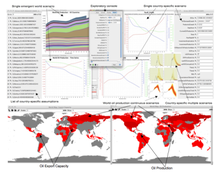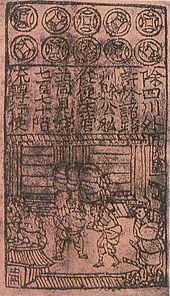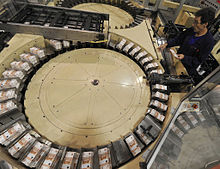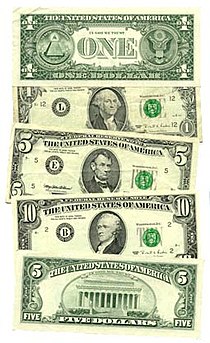Agent-based models have many applications in biology, primarily due to the characteristics of the modeling method. Agent-based modeling is a rule-based, computational modeling methodology that focuses on rules and interactions among the individual components or the agents of the system.
The goal of this modeling method is to generate populations of the
system components of interest and simulate their interactions in a
virtual world. Agent-based models start with rules for behavior and
seek to reconstruct, through computational instantiation of those
behavioral rules, the observed patterns of behavior. Several of the characteristics of agent-based models important to biological studies include:
- Modular structure: The behavior of an agent-based model is defined by the rules of its agents. Existing agent rules can be modified or new agents can be added without having to modify the entire model.
- Emergent properties: Through the use of the individual agents that interact locally with rules of behavior, agent-based models result in a synergy that leads to a higher level whole with much more intricate behavior than those of each individual agent.
- Abstraction: Either by excluding non-essential details or when details are not available, agent-based models can be constructed in the absence of complete knowledge of the system under study. This allows the model to be as simple and verifiable as possible.
- Stochasticity: Biological systems exhibit behavior that appears to be random. The probability of a particular behavior can be determined for a system as a whole and then be translated into rules for the individual agents.
Forest insect infestations
In
the paper titled "Exploring Forest Management Practices Using an
Agent-Based Model of Forest Insect Infestations", an agent-based model
was developed to simulate attack behavior of the mountain pine beetle, Dendroctonus ponderosae,
(MPB) in order to evaluate how different harvesting policies influence
spatial characteristics of the forest and spatial propagation of the MPB
infestation over time. About two-thirds of the land in British Columbia, Canada is covered by forests that are constantly being modified by natural disturbances
such as fire, disease, and insect infestation. Forest resources make
up approximately 15% of the province’s economy, so infestations caused
by insects such as the MPB can have significant impacts on the economy.
The MPB outbreaks are considered a major natural disturbance that can
result in widespread mortality of the lodgepole pine
tree, one of the most abundant commercial tree species in British
Columbia. Insect outbreaks have resulted in the death of trees over
areas of several thousand square kilometers.
The agent-based model developed for this study was designed to simulate the MPB attack behavior in order to evaluate how management
practices influence the spatial distribution and patterns of insect
population and their preferences for attacked and killed trees. Three
management strategies were considered by the model: 1) no management, 2)
sanitation harvest and 3) salvage harvest. In the model, the Beetle
Agent represented the MPB behavior; the Pine Agent represented the
forest environment and tree health evolution; the Forest Management
Agent represented the different management strategies. The Beetle Agent
follows a series of rules to decide where to fly within the forest and
to select a healthy tree to attack, feed, and breed. The MPB typically
kills host trees in its natural environment in order to successfully
reproduce. The beetle larvae
feed on the inner bark of mature host trees, eventually killing them.
In order for the beetles to reproduce, the host tree must be
sufficiently large and have thick inner bark. The MPB outbreaks end
when the food supply decreases to the point that there is not enough to
sustain the population or when climatic conditions become unfavorable
for the beetle. The Pine Agent simulates the resistance of the host
tree, specifically the Lodgepole pine tree, and monitors the state and
attributes of each stand of trees. At some point in the MPB attack, the
number of beetles per tree reaches the host tree capacity. When this
point is reached, the beetles release a chemical to direct beetles to
attack other trees. The Pine Agent models this behavior by calculating
the beetle population density per stand and passes the information to
the Beetle Agents. The Forest Management Agent was used, at the stand
level, to simulate two common silviculture
practices (sanitation and salvage) as well as the strategy where no
management practice was employed. With the sanitation harvest strategy,
if a stand has an infestation rate greater than a set threshold, the
stand is removed as well as any healthy neighbor stand when the average
size of the trees exceeded a set threshold. For the salvage harvest
strategy, a stand is removed even it is not under a MPB attack if a
predetermined number of neighboring stands are under a MPB attack.
The study considered a forested area in the North-Central Interior of British Columbia of approximately 560 hectare. The area consisted primarily of Lodgepole pine with smaller proportions of Douglas fir and White spruce.
The model was executed for five time steps, each step representing a
single year. Thirty simulation runs were conducted for each forest
management strategy considered. The results of the simulation showed
that when no management strategy was employed, the highest overall MPB
infestation occurred. The results also showed that the salvage forest
management technique resulted in a 25% reduction in the number of forest
strands killed by the MPB, as opposed to a 19% reduction by the salvage
forest management strategy. In summary, the results show that the
model can be used as a tool to build forest management policies.
Invasive species
Invasive species
refers to "non-native" plants and animals that adversely affect the
environments they invade. The introduction of invasive species may have
environmental, economic, and ecological implications. In the paper
titled "An Agent-Based Model of Border Enforcement for Invasive Species
Management", an agent-based model is presented that was developed to
evaluate the impacts of port-specific and importer-specific enforcement regimes for a given agricultural commodity
that presents invasive species risk. Ultimately, the goal of the study
was to improve the allocation of enforcement resources and to provide a
tool to policy makers to answer further questions concerning border
enforcement and invasive species risk.
The agent-based model developed for the study considered three
types of agents: invasive species, importers, and border enforcement
agents.
In the model, the invasive species can only react to their
surroundings, while the importers and border enforcement agents are able
to make their own decisions based on their own goals and objectives.
The invasive species has the ability to determine if it has been
released in an area containing the target crop, and to spread to
adjacent plots of the target crop. The model incorporates spatial
probability maps that are used to determine if an invasive species
becomes established. The study focused on shipments of broccoli from Mexico into California through the ports of entry Calexico, California and Otay Mesa, California. The selected invasive species of concern was the crucifer flea beetle (Phyllotreta cruciferae).
California is by far the largest producer of broccoli in the United
States and so the concern and potential impact of an invasive species
introduction through the chosen ports of entry is significant. The
model also incorporated a spatially explicit damage function that was
used to model invasive species damage in a realistic manner.
Agent-based modeling provides the ability to analyze the behavior of heterogeneous
actors, so three different types of importers were considered that
differed in terms of commodity infection rates (high, medium, and low),
pretreatment choice, and cost of transportation to the ports. The model
gave predictions on inspection rates for each port of entry and
importer and determined the success rate of border agent inspection, not
only for each port and importer but also for each potential level of
pretreatment (no pretreatment, level one, level two, and level three).
The model was implemented and ran in NetLogo,
version 3.1.5. Spatial information on the location of the ports of
entry, major highways, and transportation routes was included in the
analysis as well as a map of California broccoli crops layered with
invasive species establishment probability maps. BehaviorSpace,
a software tool integrated with NetLogo, was used to test the effects
of different parameters (e.g. shipment value, pretreatment cost) in the
model. On average, 100 iterations were calculated at each level of the
parameter being used, where an iteration represented a one-year run.
The results of the model showed that as inspection efforts
increase, importers increase due care, or the pre-treatment of shipments,
and the total monetary loss of California crops decreases. The model
showed that importers respond to an increase in inspection effort in
different ways. Some importers responded to increased inspection rate
by increasing pre-treatment effort, while others chose to avoid shipping
to a specific port, or shopped for another port. An important result of
the model results is that it can show or provide recommendations to
policy makers about the point at which importers may start to shop for
ports, such as the inspection rate at which port shopping is introduced
and the importers associated with a certain level of pest risk or
transportation cost are likely to make these changes. Another
interesting outcome of the model is that when inspectors were not able
to learn to respond to an importer with previously infested shipments,
damage to California broccoli crops was estimated to be $150 million.
However, when inspectors were able to increase inspection rates of
importers with previous violations, damage to the California broccoli
crops was reduced by approximately 12%. The model provides a mechanism
to predict the introduction of invasive species from agricultural
imports and their likely damage. Equally as important, the model
provides policy makers and border control agencies with a tool that can
be used to determine the best allocation of inspectional resources.
Aphid population dynamics
In
the article titled "Aphid Population Dynamics in Agricultural
Landscapes: An Agent-based Simulation Model", an agent-based model is
presented to study the population dynamics of the bird cherry-oat aphid, Rhopalosiphum padi (L.). The study was conducted in a five square kilometer region of North Yorkshire, a county located in the Yorkshire and the Humber region of England.
The agent-based modeling method was chosen because of its focus on the
behavior of the individual agents rather than the population as a
whole. The authors propose that traditional models that focus on
populations as a whole do not take into account the complexity of the
concurrent interactions in ecosystems,
such as reproduction and competition for resources which may have
significant impacts on population trends. The agent-based modeling
approach also allows modelers to create more generic and modular models
that are more flexible and easier to maintain than modeling approaches
that focus on the population as a whole. Other proposed advantages of
agent-based models include realistic representation of a phenomenon of
interest due to the interactions of a group of autonomous agents, and
the capability to integrate quantitative variables, differential equations, and rule based behavior into the same model.
The model was implemented in the modeling toolkit Repast using the JAVA
programming language. The model was run in daily time steps and
focused on the autumn and winter seasons. Input data for the model
included habitat data, daily minimum, maximum, and mean temperatures,
and wind speed and direction. For the Aphid agents, age, position, and morphology (alate or apterous)
were considered. Age ranged from 0.00 to 2.00, with 1.00 being the
point at which the agent becomes an adult. Reproduction by the Aphid
agents is dependent on age, morphology, and daily minimum, maximum, and
mean temperatures. Once nymphs
hatch, they remain in the same location as their parents. The
morphology of the nymphs is related to population density and the
nutrient quality of the aphid’s
food source. The model also considered mortality among the Aphid
agents, which is dependent on age, temperatures, and quality of habitat.
The speed at which an Aphid agent ages is determined by the daily
minimum, maximum, and mean temperatures. The model considered movement
of the Aphid agents to occur in two separate phases, a migratory phase
and a foraging phase, both of which affect the overall population distribution.
The study started the simulation run with an initial population
of 10,000 alate aphids distributed across a grid of 25 meter cells. The
simulation results showed that there were two major population peaks,
the first in early autumn due to an influx of alate immigrants and the
second due to lower temperatures later in the year and a lack of
immigrants. Ultimately, it is the goal of the researchers to adapt this
model to simulate broader ecosystems and animal types.
Aquatic population dynamics
In
the article titled "Exploring Multi-Agent Systems In Aquatic Population
Dynamics Modeling", a model is proposed to study the population
dynamics of two species of macrophytes. Aquatic plants play a vital role in the ecosystems
in which they live as they may provide shelter and food for other
aquatic organisms. However, they may also have harmful impacts such as
the excessive growth of non-native plants or eutrophication of the lakes in which they live leading to anoxic
conditions. Given these possibilities, it is important to understand
how the environment and other organisms affect the growth of these
aquatic plants to allow mitigation or prevention of these harmful
impacts.
Potamogeton pectinatus is one of the aquatic plant agents in the model. It is an annual growth plant that absorbs nutrients from the soil and reproduces through root tubers and rhizomes.
Reproduction of the plant is not impacted by water flow, but can be
influenced by animals, other plants, and humans. The plant can grow up
to two meters tall, which is a limiting condition because it can only
grow in certain water depths, and most of its biomass is found at the
top of the plant in order to capture the most sunlight possible. The
second plant agent in the model is Chara aspera, also a rooted
aquatic plant. One major difference in the two plants is that the
latter reproduces through the use of very small seeds called oospores
and bulbills which are spread via the flow of water. Chara aspera
only grows up to 20 cm and requires very good light conditions as well
as good water quality, all of which are limiting factors on the growth
of the plant. Chara aspera has a higher growth rate than Potamogeton pectinatus
but has a much shorter life span. The model also considered
environmental and animal agents. Environmental agents considered
included water flow, light penetration, and water depth. Flow
conditions, although not of high importance to Potamogeton pectinatus, directly impact the seed dispersal of Chara aspera.
Flow conditions affect the direction as well as the distance the seeds
will be distributed. Light penetration strongly influences Chara aspera as it requires high water quality. Extinction coefficient (EC) is a measure of light penetration in water. As EC increases, the growth rate of Chara aspera
decreases. Finally, depth is important to both species of plants. As
water depth increases, the light penetration decreases making it
difficult for either species to survive beyond certain depths.
The area of interest in the model was a lake in the Netherlands named Lake Veluwe.
It is a relatively shallow lake with an average depth of 1.55 meters
and covers about 30 square kilometers. The lake is under eutrophication
stress which means that nutrients are not a limiting factor for either
of the plant agents in the model. The initial position of the plant
agents in the model was randomly determined. The model was implemented
using Repast
software package and was executed to simulate the growth and decay of
the two different plant agents, taking into account the environmental
agents previously discussed as well as interactions with other plant
agents. The results of the model execution show that the population
distribution of Chara aspera has a spatial pattern very similar
to the GIS maps of observed distributions. The authors of the study
conclude that the agent rules developed in the study are reasonable to
simulate the spatial pattern of macrophyte growth in this particular
lake.
Bacteria aggregation leading to biofilm formation
In
the article titled "iDynoMiCS: next-generation individual-based
modelling of biofilms", an agent-based model is presented that models
the colonisation of bacteria onto a surface, leading to the formation of
biofilms.
The purpose of iDynoMiCS (standing for individual-based Dynamics of
Microbial Communities Simulator) is to simulate the growth of
populations and communities of individual microbes (small unicellular
organisms such as bacteria, archaea and protists)
that compete for space and resources in biofilms immersed in aquatic
environments. iDynoMiCS can be used to seek to understand how individual
microbial dynamics lead to emergent population- or biofilm-level
properties and behaviours. Examining such formations is important in
soil and river studies, dental hygiene studies, infectious disease and
medical implant related infection research, and for understanding
biocorrosion.
An agent-based modelling paradigm was employed to make it possible to
explore how each individual bacterium, of a particular species,
contributes to the development of the biofilm. The initial illustration
of iDynoMiCS considered how environmentally fluctuating oxygen
availability affects the diversity and composition of a community of denitrifying bacteria that induce the denitrification pathway under anoxic or low oxygen conditions.
The study explores the hypothesis that the existence of diverse
strategies of denitrification in an environment can be explained by
solely assuming that faster response incurs a higher cost. The
agent-based model suggests that if metabolic pathways can be switched
without cost the faster the switching the better. However, where faster
switching incurs a higher cost, there is a strategy with optimal
response time for any frequency of environmental fluctuations. This
suggests that different types of denitrifying strategies win in
different biological environments. Since this introduction the
applications of iDynoMiCS continues to increase: a recent exploration of
the plasmid invasion in biofilms being one example.
This study explored the hypothesis that poor plasmid spread in biofilms
is caused by a dependence of conjugation on the growth rate of the
plasmid donor agent. Through simulation, the paper suggests that plasmid
invasion into a resident biofilm is only limited when plasmid transfer
depends on growth. Sensitivity analysis techniques were employed that
suggests parameters relating to timing (lag before plasmid transfer
between agents) and spatial reach are more important for plasmid
invasion into a biofilm than the receiving agents growth rate or
probability of segregational loss. Further examples that use iDynoMiCS
continue to be published, including use of iDynoMiCS in modelling of a Pseudomonas aeruginosa biofilm with glucose substrate.
iDynoMiCS has been developed by an international team of
researchers in order to provide a common platform for further
development of all individual-based models of microbial biofilms and
such like. The model was originally the result of years of work by
Laurent Lardon, Brian Merkey, and Jan-Ulrich Kreft, with code
contributions from Joao Xavier. With additional funding from the National Centre for Replacement, Refinement, and Reduction of Animals in Research (NC3Rs)
in 2013, the development of iDynoMiCS as a tool for biological
exploration continues apace, with new features being added when
appropriate. From its inception, the team have committed to releasing
iDynoMiCS as an open source
platform, encouraging collaborators to develop additional functionality
that can then be merged into the next stable release. IDynoMiCS has
been implemented in the Java
programming language, with MATLAB and R scripts provided to analyse
results. Biofilm structures that are formed in simulation can be viewed
as a movie using POV-Ray files that are generated as the simulation is run.
Mammary stem cell enrichment following irradiation during puberty
Experiments
have shown that exposure to ionizing irradiation of pubertal mammary
glands results in an increase in the ratio of mammary stem cells in the gland.
This is important because stem cells are thought to be key targets for
cancer initiation by ionizing radiation because they have the greatest
long-term proliferative potential and mutagenic events persist in
multiple daughter cells. Additionally, epidemiology data show that
children exposed to ionizing radiation have a substantially greater
breast cancer risk than adults.
These experiments thus prompted questions about the underlying
mechanism for the increase in mammary stem cells following radiation. In
this research article titled "Irradiation of Juvenile, but not Adult,
Mammary Gland Increases Stem Cell Self-Renewal and Estrogen Receptor
Negative Tumors", two agent-based models were developed and were used in parallel with in vivo and in vitro experiments to evaluate cell inactivation, dedifferentiation via epithelial-mesenchymal transition (EMT), and self-renewal (symmetric division) as mechanisms by which radiation could increase stem cells.
The first agent-based model is a multiscale model of mammary
gland development starting with a rudimentary mammary ductal tree at the
onset of puberty (during active proliferation) all the way to a full
mammary gland at adulthood (when there is little proliferation). The
model consists of millions of agents, with each agent representing a
mammary stem cell, a progenitor cell, or a differentiated cell in the
breast. Simulations were first run on the Lawrence Berkeley National Laboratory Lawrencium supercomputer to parameterize and benchmark the model against a variety of in vivo
mammary gland measurements. The model was then used to test the three
different mechanisms to determine which one led to simulation results
that matched in vivo experiments the best. Surprisingly,
radiation-induced cell inactivation by death did not contribute to
increased stem cell frequency independently of the dose delivered in the
model. Instead the model revealed that the combination of increased
self-renewal and cell proliferation during puberty led to stem cell
enrichment. In contrast epithelial-mesenchymal transition in the model
was shown to increase stem cell frequency not only in pubertal mammary
glands but also in adult glands. This latter prediction, however,
contradicted the in vivo data; irradiation of adult mammary
glands did not lead to increased stem cell frequency. These simulations
therefore suggested self-renewal as the primary mechanism behind
pubertal stem cell increase.
To further evaluate self-renewal as the mechanism, a second
agent-based model was created to simulate the growth dynamics of human
mammary epithelial cells (containing stem/progenitor and differentiated
cell subpopulations) in vitro after irradiation. By comparing the simulation results with data from the in vitro
experiments, the second agent-based model further confirmed that cells
must extensively proliferate to observe a self-renewal dependent
increase in stem/progenitor cell numbers after irradiation.
The combination of the two agent-based models and the in vitro/in vivo
experiments provide insight into why children exposed to ionizing
radiation have a substantially greater breast cancer risk than adults.
Together, they support the hypothesis that the breast is susceptible to a
transient increase in stem cell self-renewal when exposed to radiation
during puberty, which primes the adult tissue to develop cancer decades
later.














